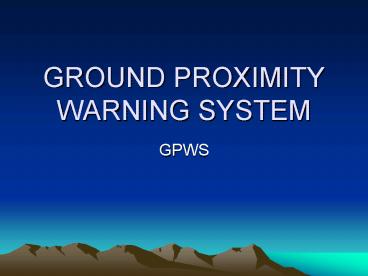GROUND PROXIMITY WARNING SYSTEM - PowerPoint PPT Presentation
1 / 22
Title:
GROUND PROXIMITY WARNING SYSTEM
Description:
'TOO LOW, TERRAIN' 'TOO LOW GEAR' 'PULL UP' ... MODE 4b: When the gear is selected down, but the flaps are still retracted 'too low, flaps' ... – PowerPoint PPT presentation
Number of Views:2427
Avg rating:3.0/5.0
Title: GROUND PROXIMITY WARNING SYSTEM
1
GROUND PROXIMITY WARNING SYSTEM
- GPWS
2
Korean Airlines Boeing 747 CFIT while attempting
to land in heavy rain 228 of 254 killed (Aug. 6,
1997) GPWS equipped
3
- Realvideo animation of Flight 801 descent
4
CFIT
- Controlled flight into terrain.
- Prior to the widespread implementation of GPWS,
CFIT was an all too common occurrence. - CFIT accidents involve a normally operating
aircraft which contacts the ground due to loss of
situational awareness, or other pilot error. - GPWS has greatly reduced the number of these
incidents.
5
GPWS
- GPWS is a system developed to help prevent CFIT
accidents. - In the event of a loss of situational awareness
by the crew GPWS is a last resort lifeline to
warn of approaching terrain. - The pilots are alerted through aural and visual
warnings and in the case of EGPWS a visual
display.
6
HOW IT WORKS
- The heart of the GPWS is a computer processor
which interprets data from a number of sources - Radar altimeter
- Air data computer
- UHF Nav receiver
- Gear and flap indicating system
- Roll attitude input sensor
7
HOW IT WORKS
- The computer analyzes a number of parameters
including aircraft configuration, speed,
proximity to terrain, and descent rate in order
to issue appropriate warnings. - If the aircraft is in landing configuration at
approach speed and approaching the ground it is
deemed a warning is unnecessary.
8
(No Transcript)
9
AURAL WARNINGS
- Some typical GPWS warnings are
- SINK RATE
- TERRAIN, TERRAIN
- DONT SINK
- TOO LOW, TERRAIN
- TOO LOW GEAR
- PULL UP
- These aural warnings will be accompanied by
illumination of a GPWS annunciator. - In the event of a PULL UP warning a recovery
procedure must be initiated.
10
MODE 1
- Warns of excessive descent rate.
- If the aircraft is less than 2500AGL, as
determined by the radar altimeter, and is losing
altitude too quickly. - A GPWS warning light will illuminate and sink
rate, sink rate will be heard. - If the situation is not corrected whoop, whoop,
pull up, pull up will be heard.
11
MODE 2
- Warns crew when closure rate with terrain is too
high. - Designed to warn crew when rising terrain is a
threat. - terrain, terrain
- whoop, whoop, pull up, pull up
- There may be no change in barometric altitude but
the radar altitude is decreasing.
12
MODE 3
- Warns of loss of altitude after take-off, or
go-around. - Within the first 1000 AGL if the aircraft starts
to sink rather than climb. - If the aircraft sinks 10 percent of its radar
altitude dont sink will be heard.
13
MODE 4
- MODE 4a if the aircraft is too low and slow,
with landing gear retracted. - too low, gear
- If the airspeed is higher the warning will be
too low, terrain - MODE 4b When the gear is selected down, but the
flaps are still retracted too low, flaps - This warning can be canceled by the pilot in the
event of a flapless landing.
14
MODE 5
- Warns the crew of glideslope deviations.
- When the aircraft receives a valid glideslope and
sinks two dots below glideslope will be heard. - The warning will continue with increasing
intensity if the problem is not corrected. - This warning may be canceled by the pilot.
15
RECOVERY PROCEDURE
- Recovery procedure will vary depending on the
type of aircraft, but the general response is - Roll level and simultaneously set maximum power.
- Slowly pitch up and maintain Vx.
- Retract gear and flaps.
- Continue climb until clear of terrain.
- NOTE in VMC conditions terrain may be avoided
visually.
16
ADVISORY CALLOUTS
- GPWS is capable of advisory callouts as an aid to
normal operations - GLIDESLOPE two dots below glideslope
- FIVE HUNDRED 500 AGL on non-precision approach
- MINIMUMS, MINIMUMS upon reaching radar
altimeter selected decision height.
17
EGPWS
- Enhanced Ground Proximity Warning System
- A limitation of GPWS is the fact that with radar
altimeter information only the aircraft is only
capable of seeing terrain directly below. - In the case of rapidly rising terrain it may not
react quick enough to issue a warning in time.
18
- EGPWS corrects this problem by integrating an
aircraft navigational source into the system. - GPS position in conjunction with a terrain
database is used to help predict terrain
conflict. - Any catalogued man made obstructions are included
in the database. - This type of system can be used to display
terrain profile to the pilot to improve
situational awareness.
19
(No Transcript)
20
(No Transcript)
21
(No Transcript)
22
(No Transcript)

